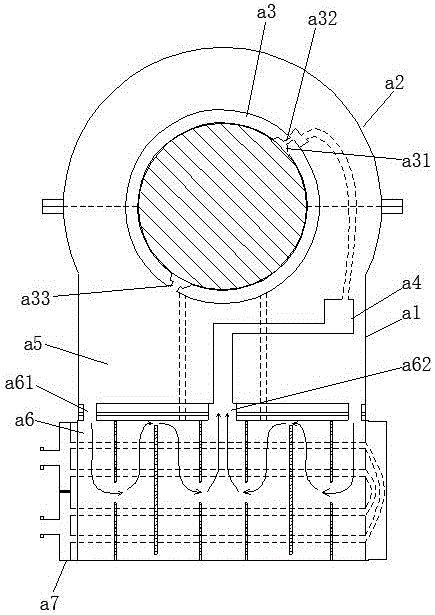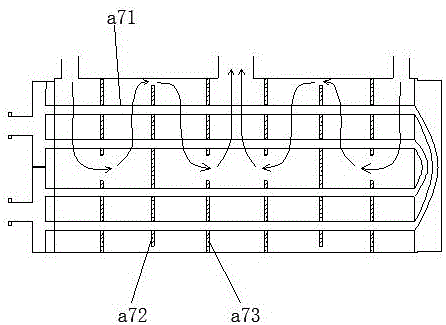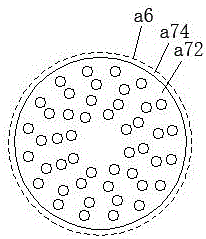Bearing
A technology for bearings and housings, which is applied to bearing components, shafts and bearings, bearing cooling, etc. It can solve the problems of low cooling oil exchange rate, sinking of cooling oil, and increased frictional heat generation, etc.
- Summary
- Abstract
- Description
- Claims
- Application Information
AI Technical Summary
Problems solved by technology
Method used
Image
Examples
Embodiment 1
[0116] a bearing such as Figure 5 , Image 6 with Figure 7 As shown, it includes bearing seat 1, bearing cover 2, shoe seat 3, support shoe 41, forward thrust shoe 42, reverse thrust shoe 43, forward thrust plate 51, reverse thrust plate 52, first oil chamber 6, second oil chamber 7. Cooler 8 and oil cover 9; the bearing cover 2 is used to cover the top of the bearing seat 1, the shoe seat 3 is fixed on the bearing seat 1, and the supporting shoe 41 is fixed on the inner diameter of the shoe seat 3 side, the axial ends of the tile seat 3 are the front end and the rear end respectively, the forward thrust shoe 42 is fixed on the front end of the tile seat 3, the reverse thrust shoe 43 is fixed on the rear end of the tile seat 3, and the forward thrust The disk 51 is attached to the front end of the forward thrust pad 42, the reverse thrust pad 43 is attached to the rear end of the reverse thrust pad 43, and the forward thrust disk 51 and the reverse thrust disk 52 are coaxi...
Embodiment 2
[0129] The difference from Embodiment 1 is that: Figure 19 As shown, the inner surface of the support shoe 41 includes at least two oil injection grooves 411 , and the oil injection grooves 411 are spirally distributed on the inner surface of the support shoe 41 . With the conventional oil tank structure, the oil film fracture is prone to occur in the area far away from the oil tank. The sliding friction of the oil film fracture zone produces large heat, the heat conduction speed is slow, and it is easy to cause the burning of the pads; this method can effectively prevent the fracture of the oil film between the bearing pad and the shaft body.
[0130] Using the implementation of the above example, it is used to test the support shoe 41 and the oil temperature of the bearing. After three hours of operation, the temperature of the support shoe 41 tends to be stable within 44.5°C, and the oil temperature tends to be stable at about 35°C.
Embodiment 3
[0132] The difference from Embodiment 1 is that: Figure 20 As shown, the oil discharge groove 412 includes a first oil discharge groove 412a and a second oil discharge groove 412b, the first oil discharge groove 412a and the second oil discharge groove 412b are respectively located at the two ends of the oil injection groove 411, and the first oil discharge groove 412a is connected to the oil injection groove 412b. The distance between the oil grooves 411 is 30mm, the distance between the second oil discharge groove 412b and the oil injection groove 411 is 30mm, and the first oil discharge groove 412a is provided with an oil discharge hole 414, and the first oil discharge groove 412a passes through the oil discharge hole 414 and The first oil chamber 6 communicates, and the second oil discharge groove 412 b is a semi-open groove, directly communicating with the first oil chamber 6 .
[0133] Using the implementation of the above example, it is used to test the support shoe 41...
PUM
 Login to View More
Login to View More Abstract
Description
Claims
Application Information
 Login to View More
Login to View More - R&D
- Intellectual Property
- Life Sciences
- Materials
- Tech Scout
- Unparalleled Data Quality
- Higher Quality Content
- 60% Fewer Hallucinations
Browse by: Latest US Patents, China's latest patents, Technical Efficacy Thesaurus, Application Domain, Technology Topic, Popular Technical Reports.
© 2025 PatSnap. All rights reserved.Legal|Privacy policy|Modern Slavery Act Transparency Statement|Sitemap|About US| Contact US: help@patsnap.com



